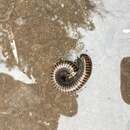Comprehensive Description
provided by Memoirs of the American Entomological Society
Spirobolus grahami
Diagnosis. — Distinguished from all other species in the genus by the large, suboval prefemoral endites of the male posterior gonopods. The very thick distal lobe with a deep groove down the cephalic face makes the female cyphopod equally distinctive.
Description.— L oi males 75-130 mm. (99.3), of females 82-117 mm. (98.3) ; W of males 7.3-8.9 mm. (8.3), of females 7.8-9.3 mm. (8.5) ; L/W of males 10.7-14.4 (12.2), of females 10.4-12.6 (11.3). Segments 46-54 (50.4).
Face broad, lateral edges of clypeus not, or only slightly, exceeded by second segment of antenna. Lateral corners of clypeus relatively distinct, antennal groove thus well-defined anteriorly ; groove not well-defined posteriorly, parietal sclerite sloping gradually cauded. Mandibular cheek only slightly grooved ; distal margin of stipes always concave, the concavity usually V-shaped and of variable depth. Eyes per patch 34-49 (40.1). Clypeal setae 6-10 {7.7); labral setae 14-20 (16.8).
Paranota of collum long, their ends broadly rounded or subtruncate; anterior margin of collum usually abruptly angled at level of eye patches, sometimes only slightly angled ; margining ridge very faint. Second segment only slightly surpassing ends of collum, its production not knob-like but, rather, forming a thick rounded carina running along anterior two-thirds of ventrolateral margin. Cephalic plate of second segment of female with a shallow notch in its mesal margin.
Anal valves only slightly compressed ; anal lips distinct but variable in prominence, sometimes only barely distinct, sometimes large with moderately deep depressions delimiting them.
First and second legs short. Coxae of male legs 3-7 with short rounded productions each bearing a long, seta ; claws less than half as long as last podomeres. Postgenital legs with few ventral setae (e.g. 1-1-0-0-0-2).
Mesal process of sternum of anterior gonopods moderately large. Posterior telopodite long, much less concave than in bungii or walkeri, with a large unsclerotized distal pad. Prefemoral portion of telopodite large but without the distinct shoulder seen in bungii and walkeri. Prefemoral endite large, subovoid, its long axis, if projected, would meet telopodite at approximately a right angle; no notch in mesal margin of endite.
Cyphopod very thick distally ; cephalic face of distal lobe cut by a deep groove running longitudinally down its midline, this groove sometimes extending across distal end and a short way onto caudal face. Lateral flange toothed, number and distribution of teeth variable; distal shoulder of flange often produced to form a first, usually small, tooth ; a second tooth always present just proximal of first, this often long but usually not acute distally, often almost truncate or with irregular distal edge ; a third tooth on basal portion of flange present or absent, acute when present.
Distribution. — Known from the provinces of Szechuan and Kueichow in China.
Specimens Examined. — 12 (4 males, 8 females).
China. — Szechuan : Suifu [= Ipin] (male holotype; 1 male, 3 female, 1 subadult female paratypes), D. C. Graham (USNM); south of Suifu, alt. 1,0002,000 ft., Sept. 9, 1929 (1 male, 1 female paratypes), Graham No. 107737 (USNM) ; south of Suifu on the Yunnan border, alt. 2,000-3,000 ft., about May 15, 1929 (1 female), D. C. Graham (USNM); Mupin, alt. 7,000 ft., July 12, 1929 (1 female), Graham (USNM) ; near Yueh-Shi, alt. 6,000-10,000 ft., July 20-23, 1928 (1 female), Graham (USNM) ; Mt. Omei, 11,000 ft, Aug. 19, 1934 (1 female), Graham (USNM). Kweichow: Shih Men Kan, July, 1934 (1 male paratype), Graham (USNM).
- bibliographic citation
- Keeton, W.T. 1960. A Taxonomic Study of the Milliped Family Spirobolidae (Diplopoda: Spirobolida). Memoirs of the American Entomological Society vol. 17. Philadelphia, USA

